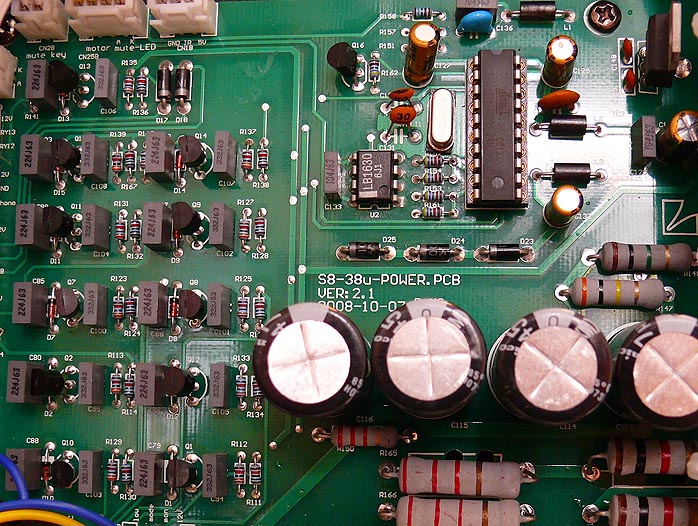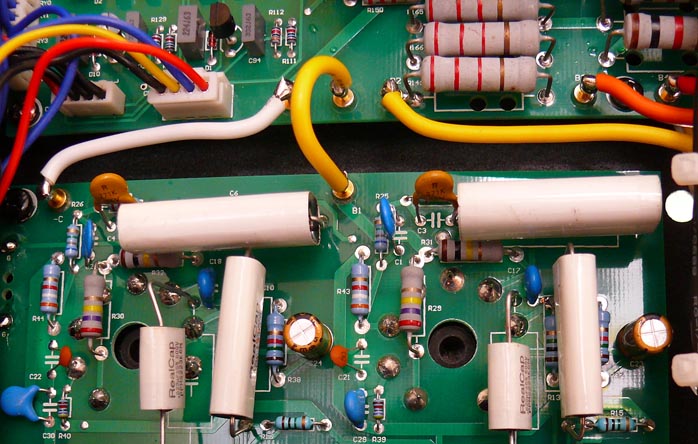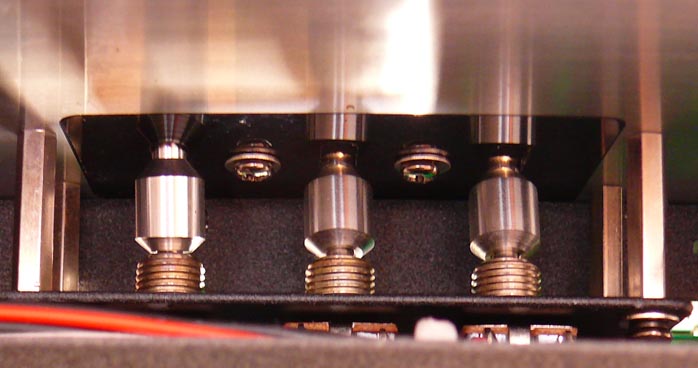This review page is supported in part by the sponsors whose ad banners are displayed below |
 |
 |
Over close to three years, my standard for headphone amplification has been Yamamoto SoundCraft's HA-02 from Japan. It is a $975 Western Electric 408A pentode-based single-ended affair without feedback. In my arsenal, the Yamamoto is followed by the far costlier Woo Audio Model 5 ($4,000 with all the options) which I have equipped with EML 5U4G rectifiers and EAT 300Bs. Priced like the Woo and like it a full-blown integrated speaker amplifier with headphone outputs, the SQ-38u performed on their level, albeit with its very own and different perspective.
|
 |
It was more linear than the Yamamoto, with more emphasis on the transients versus the Yamamoto's greater bloom portion. The Luxman was a bit sharper on the attacks and broader of stage scale but not as sculpted and holographic in the midrange. The SEP's color temperature setting was clearly hotter and seemingly pressurized from within. This created a more close-up intimate perspective which more peeled soloists out of the mix. The Luxman was more even, seemingly more distant though occupying the same headspace. It had more crunch in the lower reaches and more apparent treble tinkle. The latter was actually a sleight of ear caused by the WE408A's greater midrange emphasis. The Yamamoto is patently voiced and cunningly contoured. But knowing it renders one no less immune to its charms.
|
|
|
|
|
In their plush velour, my Beyer Dynamics aren't merely gray of countenance. By comparison to the wood-clad red W-1000s, they're also sonically grayer and in my book, far seconds. They beg for an infusion of color upfront. This the Yamamoto provided to a rather greater extent than the Luxman. My top-line Grados sadly didn't survive one of our moves but if memory is any indication, their particular voicing should better suit the SQ-38u than HA-02. The headphone output of my desk-top Peachtree Nova was clearly overshadowed by the valve showing of the Luxman. Ditto the socket on the Aura Note Premier which itself edges out the Nova on the BDs. Naturally, none of these comparators remotely approach the asking price of the SQ-38u. And, none of them equal what the Luxman can do on proper loudspeakers.

As a dedicated headphone amp, the SQ-38u is too expensive for most. But if you had tagged a good $1,000 for a top-line can amp, the Luxman's 1/4" output will more than hold its own and quite possibly be superior. Further in its favor are the fancy tone controls. They can be far handier for in-the-brain music sessions than you might think if you've never tried it. Luxman's own SQ-N100 is another very good can amp whose output rating for speaker drive halves just like the sticker. Its EL84s are lighter and faster than the EL34s in the SQ-38u and if you favor energy, élan and resolution over weight and a lower acoustic center, you could even prefer the smaller sibling. The simple upshot is, don't book an audition with the SQ-38u whilst not bringing quality headphones. That would be like test-driving a 4x4 only on the freeway. It misses half the picture.
|
 |
On speakers: The Luxman's gain relative to volume taper is exceedingly front-heavy. On my 91dB-rated reference speakers standing in for normalcy, I couldn't get past 9:00 o'clock before things got to loud. Forget my 97dB and 98dB Zus and Rethms. The SQ-38u isn't the first lower power valve amp to go loud quickly. Like the published 30wpc rating into 6 ohms (it's really 25wpc into the standard 8-ohm spec), perhaps this lead foot on the gas is supposed to reassure I've- got-100-watt-speakers shoppers. Post audition however, a shallower taper would be far more real world and useful. This is the amp's only functional flaw.
Sonically, the SQ-38u is a bit looser and rumblier in the bass than equivalent KT88-fitted Octave models that apply higher damping for greater snap. Luxman also harvests more tube tone than the cooler, more transistory German amplifiers. The SQ-38u nearly seems boosted in the lower harmonics. Color saturation is rich and somewhat shades the upper harmonics to veer into copperish gold away from Platinum. It diminishes the finest overtone sprays and decays and thickens up the stew a bit. That shifts the subjective perspective between separation/visibility versus connectivity/density towards the latter.
Image focus—getting an unwavering fix on performance location—was rock solid indeed but itself not as holographically pungent as the best SETs. Not a matter of where in space, this pertains to sculpting and relief relative to surrounding space. Stage depth was shallower than over my Yamamoto triodes or FirstWatt F5 but stage width comparable. Bass weight was truly formidable and impressive not just for valves. The slightly relaxed control around the edges particularly down low was a giveaway again of the output devices.
|
 |
With the tonal balance center shifted downwards, top-end air diminished and the bass tyre bled for a softer cushier ride, the SQ-38u belongs into the comfort sound camp. Its emphasis was more on the bigger than minute gestures, more on great dynamic scaling over longer arcs than the intermittent spikes poking out of the thicket. The weighty low end and potent macrodynamic scaling outshone deep tone modulations and dynamic micro cues. The focus was on impact, wallop, richness and warmth instead.
If from that you arrive at something approaching the vintage cosmetics, you'd be perfectly correct. What Luxman has done is retain the general sound aesthetic but build out frequency response and tighten up overall articulation. Hence the SQ-38u has fully modern extension on either end and the kind of low noise floor 21st-century listeners demand. What's more yesteryear is the unapologetic focus on deeply rendered colors that enhance the aspect of musical beauty. With the widespread demise of contemporary composers working in the classic romantic or impressionist style—historically just like in painting, those periods were followed by experimentation and abstraction—it's a seemingly modern fascination to have these arts reflect the ugliness of the reality we have made. Must make political or sociological statements, shock and antagonize seems the implied task. The older—perhaps idealized—appeal to higher values around universal harmony, beauty and spirit has been usurped by the scientific doubting mind. It's curious however how any type of healing modality involving music, plants, humans and animals always relies on classical music. Shouldn't that tell us something?
|
|
|
In that sense then, the SQ-38u does return one to such bygone values. It's fair to say that hard-hitting modern music will get subtly made over to sound prettier, fuller and more 'ensouled' than electronic. Whether that's considered an asset or deviation from truth depends on the listener. Owning the Eastern Electric M520 integrated, likewise a Mullard-based EL34 integrated, the Luxman is far superior. While it's rightfully been pointed out that the M520 rather improves when its built-in preamp stage is bypassed, that quite defeats the purpose of an integrated amplifier. Where the M520 is sloppily vintage, the SQ-38u is spick and span like a Victorian house that's been lovingly upkept or renovated. It's turn-key move-in ready but rather more charming than a modern concrete/glass bungalow. And, this entire character sketch can still be shifted by using the Luxman's sophisticated tone controls (I'd personally tweak the highs a bit).
|
 |
Bring the bill: Considering Japanese manufacture, the SQ-38u's comprehensive features and impeccable build quality—a full-on MM/MC tube phono stage alone could readily command $1,000 if not more—the asking price is super attractive and fair. If precursors of this amp and how well regarded they remain are anything to go by, the SQ-38u has heirloom factor written all over it. While the company's portfolio has adapted to modernity, this particular model was clearly meant as a record of past glories. For what it is and wants to be, it's a real winner. Its only competition is probably an Audiomat (you'd lose most the features) or Leben (no phono). Considering, perhaps Luxman's exact combination of features, performance and price really is exclusive? I think it might be indeed. |
|
|
Quality of packing: Very good.
Reusability of packing: A few times.
Ease of unpacking/repacking: Easy.
Condition of component received: Flawless.
Completeness of delivery: Perfect except for Japanese owner's manual. That should have been English.
Website comments: Very recently overhauled and much improved.
Human interactions: Zero response to e-mail inquiries from the global website to suggest very archaic attitudes in Japan, instant response from the US distributor who was far better informed than the French.
Pricing: Eminently fair.
Final comments & suggestions: Volume taper should be shallower. At present, the gain is front heavy and comes on too quickly. The old-fashioned tone controls are high quality and thus, very useful. The headphone output taps into the main amplification circuit to deliver serious performance. The preamplifier stage is an active tube affair, not buffered volume pot. The phono stage is all tube. Remote controls volume and mute. Amp runs quite warm and the vented top should not be obscured. |
 |
|
 |
|